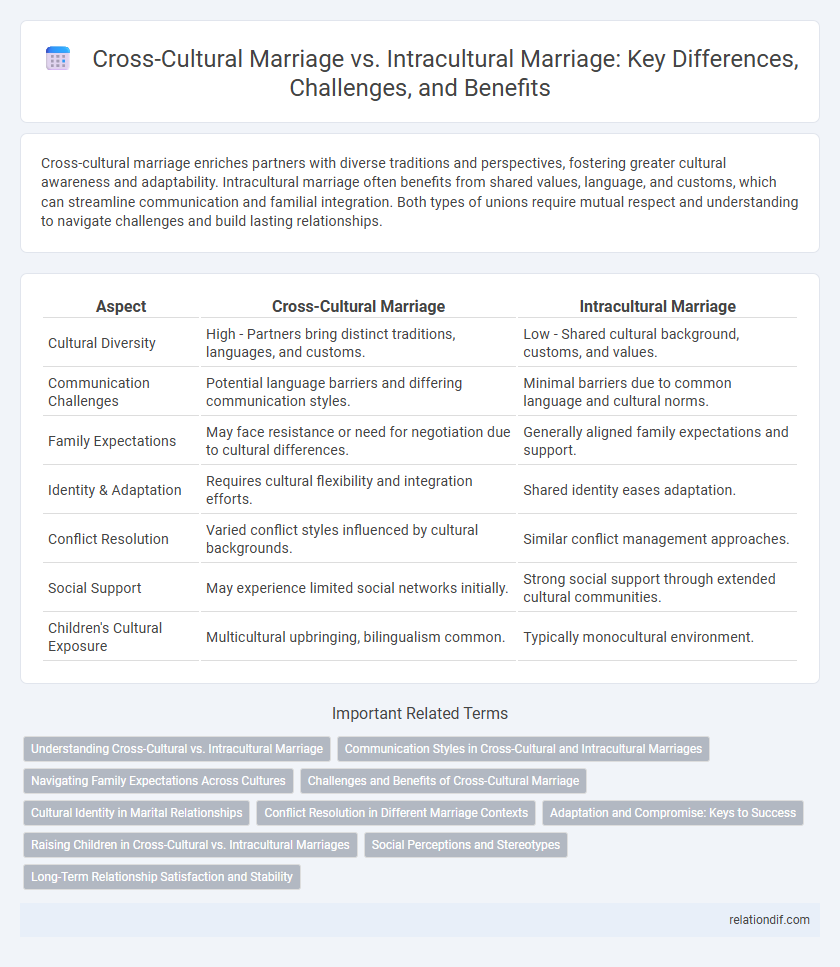Cross-cultural marriage enriches partners with diverse traditions and perspectives, fostering greater cultural awareness and adaptability. Intracultural marriage often benefits from shared values, language, and customs, which can streamline communication and familial integration. Both types of unions require mutual respect and understanding to navigate challenges and build lasting relationships.
Table of Comparison
| Aspect | Cross-Cultural Marriage | Intracultural Marriage |
|---|---|---|
| Cultural Diversity | High - Partners bring distinct traditions, languages, and customs. | Low - Shared cultural background, customs, and values. |
| Communication Challenges | Potential language barriers and differing communication styles. | Minimal barriers due to common language and cultural norms. |
| Family Expectations | May face resistance or need for negotiation due to cultural differences. | Generally aligned family expectations and support. |
| Identity & Adaptation | Requires cultural flexibility and integration efforts. | Shared identity eases adaptation. |
| Conflict Resolution | Varied conflict styles influenced by cultural backgrounds. | Similar conflict management approaches. |
| Social Support | May experience limited social networks initially. | Strong social support through extended cultural communities. |
| Children's Cultural Exposure | Multicultural upbringing, bilingualism common. | Typically monocultural environment. |
Understanding Cross-Cultural vs. Intracultural Marriage
Cross-cultural marriage involves partners from different cultural backgrounds, requiring navigation of diverse traditions, values, and communication styles, which can enhance mutual understanding and adaptability. Intracultural marriage typically shares common cultural foundations, often resulting in fewer cultural conflicts but potentially less exposure to diverse worldviews. Understanding these dynamics is crucial for fostering respect, effective communication, and conflict resolution in both types of marriages.
Communication Styles in Cross-Cultural and Intracultural Marriages
Communication styles in cross-cultural marriages often blend diverse verbal and nonverbal cues, requiring partners to develop cultural sensitivity and adaptability to bridge differences. Intracultural marriages typically share similar communication norms, enabling smoother exchanges and fewer misunderstandings rooted in cultural context. Effective communication in both marriage types hinges on mutual respect and open dialogue to navigate unique challenges and enhance relational intimacy.
Navigating Family Expectations Across Cultures
Cross-cultural marriages often involve navigating diverse family expectations rooted in different cultural traditions, requiring open communication and mutual respect to bridge varying beliefs about roles, rituals, and values. Intracultural marriages typically benefit from shared cultural norms, easing the alignment of family expectations but may still face challenges related to individual differences and generational perspectives. Successfully managing family expectations in both contexts depends on understanding cultural nuances and fostering empathy to create a supportive environment for the couple.
Challenges and Benefits of Cross-Cultural Marriage
Cross-cultural marriage often presents challenges such as language barriers, cultural misunderstandings, and differing family expectations, which require effective communication and cultural sensitivity for successful navigation. Despite these obstacles, cross-cultural unions offer unique benefits including the blending of diverse traditions, broader worldviews, and enhanced adaptability in multicultural environments. Compared to intracultural marriages, cross-cultural couples frequently develop stronger conflict resolution skills and greater appreciation for diversity, enriching their relationship dynamics.
Cultural Identity in Marital Relationships
Cross-cultural marriages often require partners to navigate complex negotiations of cultural identity, blending traditions and values to create a shared understanding while respecting individual backgrounds. In contrast, intracultural marriages typically experience greater cultural alignment, which can reduce conflicts related to differing customs and social expectations. Both types of marriages demand open communication and adaptability to maintain a harmonious relationship amid varying degrees of cultural integration.
Conflict Resolution in Different Marriage Contexts
Cross-cultural marriages often require tailored conflict resolution strategies due to contrasting cultural norms, communication styles, and expectations, which can lead to misunderstandings and tension if not addressed effectively. Intracultural marriages tend to benefit from shared cultural frameworks, making conflict resolution more predictable and aligned with common values and practices. Understanding these dynamics enables couples in both contexts to develop adaptive communication skills and negotiation tactics that foster mutual respect and long-term relationship stability.
Adaptation and Compromise: Keys to Success
Successful cross-cultural marriage demands heightened adaptation and flexibility to navigate differing traditions, languages, and values, fostering mutual respect and understanding. Intracultural marriages often benefit from shared cultural norms, requiring less negotiation but still relying on compromise to resolve individual differences. Emphasizing open communication and willingness to embrace each other's perspectives strengthens both types of unions and promotes long-term harmony.
Raising Children in Cross-Cultural vs. Intracultural Marriages
Raising children in cross-cultural marriages often involves navigating dual traditions, languages, and values, which can enrich a child's cultural identity and adaptability. In contrast, intracultural marriages provide a more uniform cultural environment, potentially simplifying identity formation and social integration for children. Research shows children from cross-cultural families demonstrate higher cultural sensitivity and cognitive flexibility but may face challenges in balancing conflicting cultural expectations.
Social Perceptions and Stereotypes
Social perceptions of cross-cultural marriage often include stereotypes about cultural incompatibility and communication challenges, while intracultural marriage is typically viewed as more harmonious due to shared values and traditions. These stereotypes can influence acceptance and support from family and community members, impacting the couple's social integration. Research shows that overcoming such biases requires increased intercultural understanding and exposure to diverse relationships.
Long-Term Relationship Satisfaction and Stability
Cross-cultural marriage often faces unique challenges due to differing cultural norms and communication styles, impacting long-term relationship satisfaction and stability. Intracultural marriages typically benefit from shared cultural backgrounds, which may promote smoother conflict resolution and stronger relational stability. Studies indicate that while cross-cultural couples may experience initial adjustment difficulties, those who effectively navigate cultural differences can achieve comparable levels of satisfaction and longevity.
cross-cultural marriage vs intracultural marriage Infographic

 relationdif.com
relationdif.com